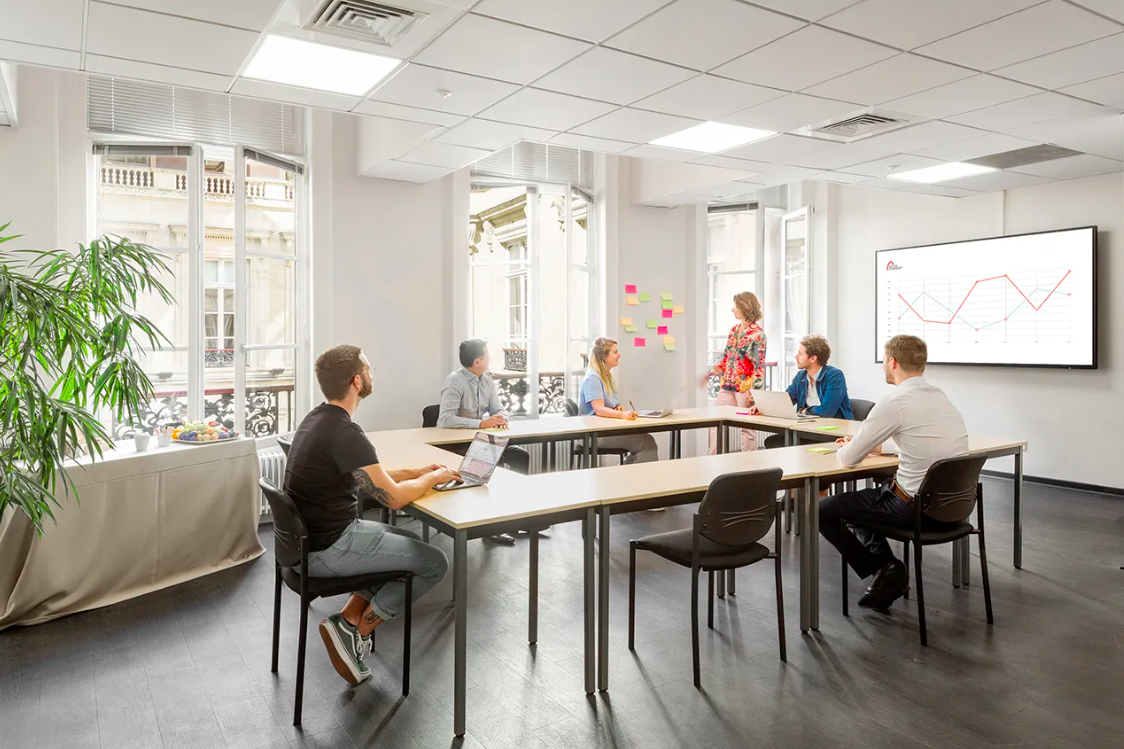The key to organize an effective professional meeting

Meetings are becoming more and more numerous in companies. Poorly planned, they can quickly become unproductive and represent a waste of time for employees. The preparation of the meeting is therefore essential to ensure its smooth and effective conduct. Define the objectives, list the participants, choose the location and the boardroom, the format, using the right equipment... This is an overview of the elements to take into account when organizing a meeting.
In this article, Formeret guides you through the essential steps to prepare an effective work meeting.
Preparing for the meeting: the essential step to deliver the right messages

Planning a meeting correctly is a guarantee ofefficiency, of productivity And of Time saver. Regardless of the types of meeting (e.g.: informational meeting, sales meeting, business meeting, problem solving meeting, discussion meeting, brainstorming, technical meeting...), this first step is essential. It is time to look at the following elements: objective (s) of the meeting, agenda, profiles and number of participants, preparation of materials. Defining clear goals is an essential prerequisite for organizing an effective meeting that can lead to fruitful decisions or discussions. So before you start preparing for a meeting, ask yourself these two questions: Why is it necessary to organize this meeting ? What is expected from the outcome of this meeting (decision making, conflict management, launching a new product, sharing information, etc.)? Each type of meeting has different goals, but these should be clear from the start of planning and shared transparently with the participants in the meeting. Choosing the right participants is also very important. The absence of a key collaborator or, on the contrary, the presence of employees who are not concerned are conditions that can be harmful for the smooth running of the meeting And theAchievement of goals. It is generally advised to limit the number of participants, and to invite only people who have a role to play and whose profile is relevant. Once your goals are set and your list of participants is ready, move on toagenda. This must be prepared meticulously, it is he who gives the pace of meetings. To help you write it, you can use a meeting agenda template (templates exist, but they should only be used as inspiration; your agenda should be unique, based on your goals and participants). To carry out effective meetings, the meeting format must also be anticipated: can you have a face-to-face meeting with all participants? Is it more convenient to organize a videoconference meeting? Finally, the choice of presentation materials can be done depending on whether it is a face-to-face meeting, remote meeting or a hybrid meeting (mix between face-to-face and video). Use varied and participatory media to maximize the engagement of those present (e.g.: PowerPoint, videos, surveys, etc.).
Practical organization: ensure the smooth running of the meeting

The next steps concern logistical elements of organizing a meeting. Here, the essential point is to choose the right meeting environment to book a meeting room that meets your needs. For this, several criteria must be taken into account, for example:
- The atmosphere of the room : choose a decor that reflects your company's image, do not hesitate to bet on unusual places if the meeting is suitable for it;
- Capacity and configuration : try to rent a meeting room spacious enough to guarantee everyone's comfort, but not too big to maintain a friendly atmosphere. The ideal is still to choose a modular room whose configuration can be adapted to your needs;
- Services and equipment : check that the meeting room you want to book has everything you need, such as a high-speed wifi connection, an overhead projector, audiovisual equipment, etc.
- Accessibility : Make sure that all employees can easily access it.
Find all the meeting rooms in Formeret: accommodating from 2 to 150 people, all our meeting spaces are versatile and flexible. In our exceptional spaces in the heart of Paris (Espace Cléry, Vinci or La Rochefoucauld), take advantage of comfortable and thought-provoking spaces to bring your employees together in the best conditions. Once the goals of your meeting are set, the date is set, and the room is booked, it's time tosend your invitations. Remember to ask for confirmation of everyone's presence. If these are regular meetings, such as a weekly meeting, we recommend that you keep the same location and time each time. Finally, don't forget the material management. This one should be checked before each meeting starts to avoid counterproductive technical problems.
Also discover our boardrooms / consumer meeting rooms / Assembly hall
Conduct of the meeting: ensuring the interest of participants

Facilitating a meeting cannot be improvised. To lead a meeting, you generally need to be leadership and master the communication techniques. Indeed, there are techniques and tools for facilitating participatory meetings that can help make the meeting dynamic and productive by encouraging participants to discuss, ask questions, or even to give free rein to their creativity. You can, for example, start your meeting with an ice breaker: this fun activity generally takes the form of a A small game that helps break the ice between participants. The ice breaker is particularly recommended when some participants do not know each other, as it helps to relax the atmosphere and create a climate of trust. If the meeting is too formal for this kind of entertainment, still opt for a Round table allowing everyone to present themselves. In all cases, the meeting leader must ensure that everyone has a speaking time to present your ideas. Facilitating a meeting also involves a good time management. To do this, announce the duration of the meeting from the start. Limiting time is a way for all employees to stay focused. Sometimes it is better to reschedule another meeting rather than extending the duration of the meeting with tired minds, as this can prevent informed decisions from being made. Finally, the Note-taking is essential. In particular, it will influence the quality of the meeting minutes and the follow-up of the meeting. Taking effective notes requires listening carefully, and rephrasing key points in a clear and understandable way. It is often difficult for the discussion leader to take on this role. The best is to designate a person responsible for taking notes among the participants.
Follow-up to the meeting: take action

The end of the meeting should not not necessarily be the end of the exchanges. The minutes of the meeting allows you to follow up. It should include all the important information: the topics discussed, the decisions taken, the tasks assigned if any, the deadlines, any unresolved questions, etc. The report helps to transform the exchanges and decisions taken into concrete actions. Don't forget to do a follow-up of these actions, for example by organizing a follow-up meeting if relevant. Conclusion: choosing the right place and the right tools for a productive meetingTo organize and facilitate a useful and productive corporate meeting, the content of the meeting must be carefully prepared (objectives, road map, etc.). But it is not the only factor in the success of a business meeting. practicalities are just as important to boost the productivity of teams in meetings. In particular, it is necessary to use the good presentation materials and tools, by relying on participatory tools (even more so if it is a remote or hybrid meeting) .In addition, The choice of location remains an essential criterion. Some meetings require thought and creativity, this is the case for a kick-off meeting, a training session, a launch meeting or even a brainstorming session. In these cases, it may be a good idea to opt for a location outside the company, and ideally for an atypical and pleasant space. Indeed, these meeting rooms are conducive to exchanges, creativity and conviviality: essential elements for participants involved in the success of the meeting.